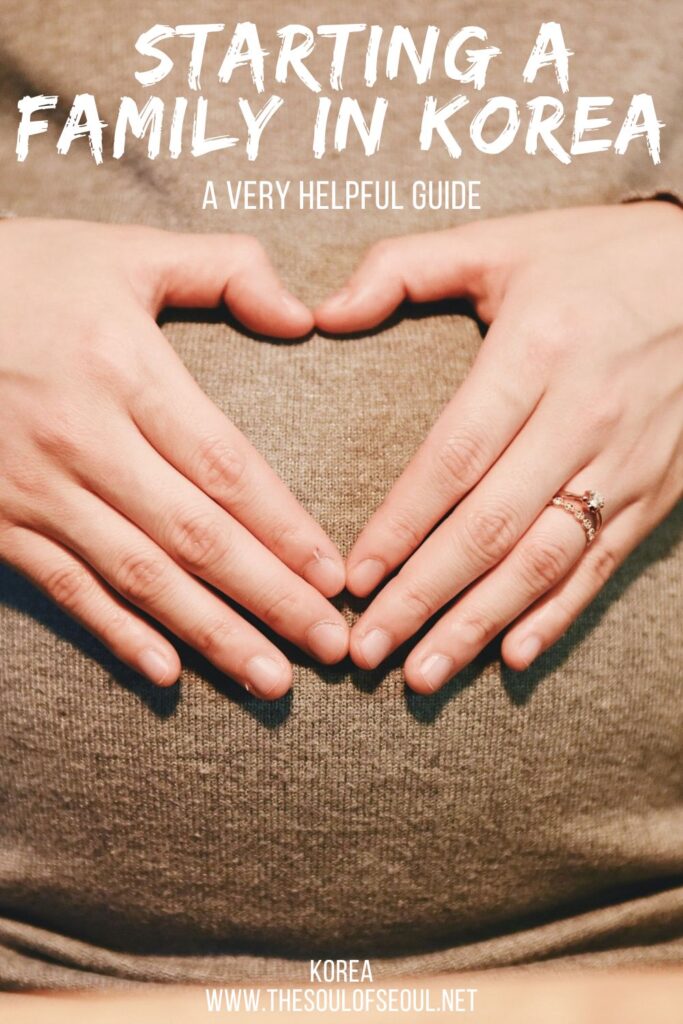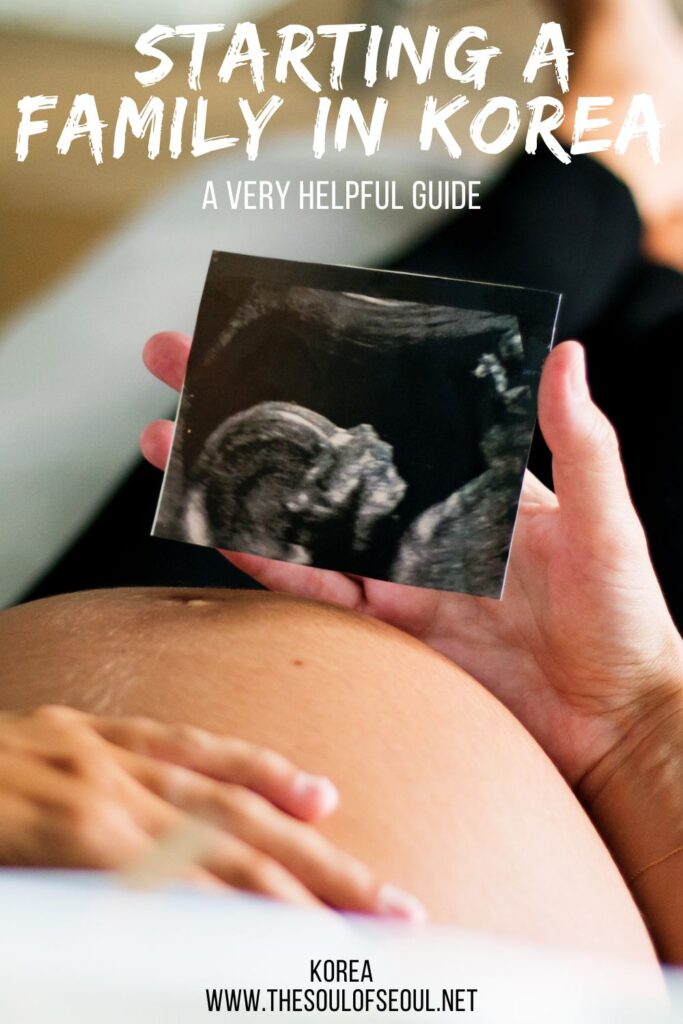A Helpful Guide for Foreign Couples Starting A Family In Korea
Last Updated on November 16, 2023
This article is a compilation of information that our local Jax Monchick put together during her stay here in South Korea. If you’re looking to start a family in Korea, there is a lot of information you should be aware of and a lot of things are different if you and your partner are both foreigners versus when you’re married with a Korean citizen.
Things can change over time, but this is a great basis of information if you are starting a family here in Korea. Are you pregnant in Korea? Trying to get pregnant? Wondering about that pregnancy badge or maternity leave? It’s all here.
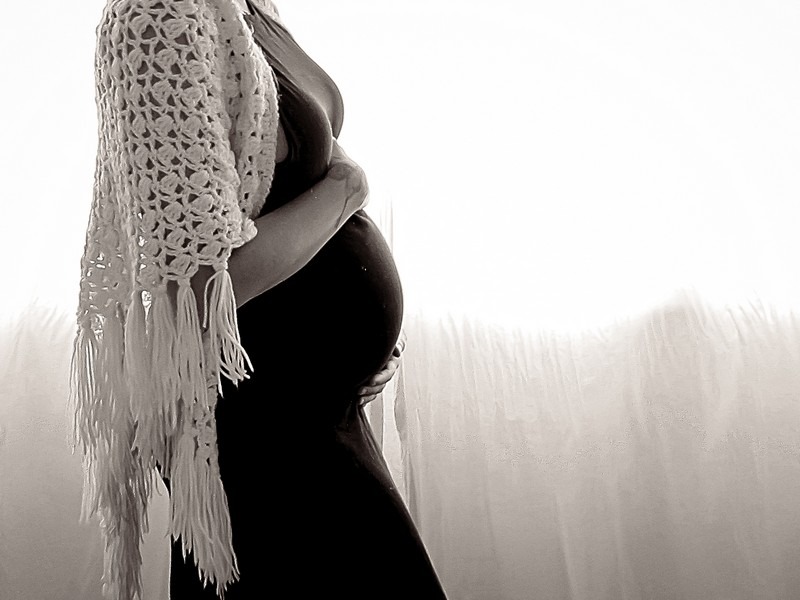
This information was a collaborative effort by folks who are currently going through or have gone through the process of starting a family in South Korea. Jax also wanted to ensure that this is a growing document and it is always open for contributions. If you see that something has changed, please leave a comment at the bottom so we can update information accordingly.
Are you pregnant in Korea? Want to start a family in Korea? Here is where to start:
- Things to think about if you’re starting a family in Korea
- Infertility Clinics
- What to do when you find out you’re pregnant in Korea
- Birthing In Korea
- Heading home with a baby
Who is this information for?
Intended for couples who are considered foreign residents of South Korea, this may or not pertain to people married with a Korean spouse and members of the US military stationed here. Some of it will, but not all of it does so keep that in mind as you read. Specifically, if you have an Alien Resident Card (ARC) AND are enrolled in National Health Insurance (NHI) you will find some useful information here.
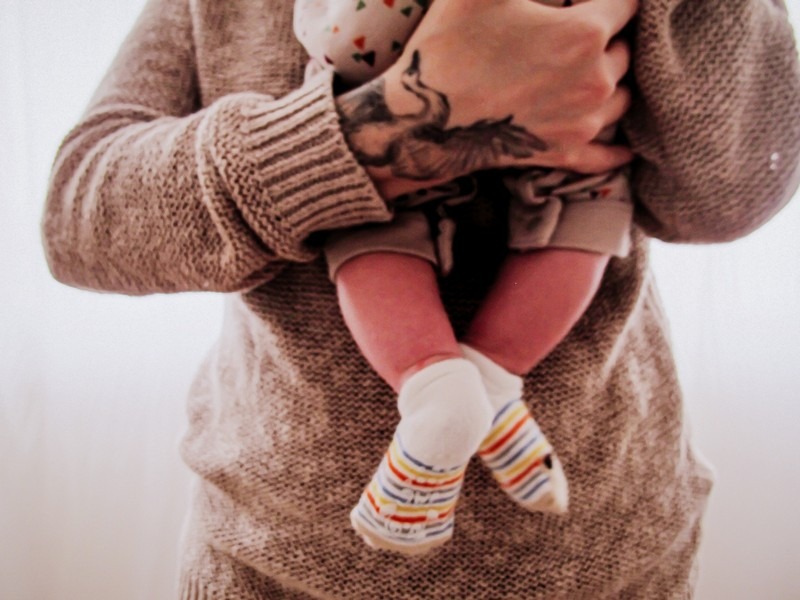
Things to think about if you’re starting a family in Korea
Important things to note:
- IVF: In Korea, if you’re interested in IVF, you must be married to a person of the opposite sex. This is a requirement by law.
- IVF is not currently covered by NHI if you AND your spouse are not Korean citizens.
What is covered by NHI
- Labor Standards Act: Article 74: Protection of Pregnant Women (임산부의 보호: 제74조) (March 2020)
- Employers must give a pregnant woman 90 days (singleton) / 120 days (multiple births) maternity leave which can fall before and after childbirth but at least 45 (singleton) / 60 (multiple births) days must fall after childbirth.
- Employers must ensure that pregnant female workers can use the full amount of maternity leave at any time before giving birth if they claim to leave for reasons prescribed by Presidential Decree which may include:
- Miscarriage or stillbirth
- Female workers are over 40 years old at the time of requesting post-birth leave
- Submits a medical certificate that indicates that there is a risk of miscarriage or stillbirth.
- Employers must give maternity leave for a miscarriage or stillbirth as prescribed by Presidential Decree. However, this is not the case for abortions under artificial abortion surgery (except for cases under Article 14 (1) of the Mother and Child Health Act).
- The first 60 (singleton) / 75 (multiple births) days of maternity leave in accordance with paragraphs 1 through 3 above, must be paid. However, in cases where maternity leave benefits before and after childbirth are paid pursuant to Article 18 of the Gender Equality Employment and Work-family Balance Support Act. The responsibility for payment is waived within the limits of the amount.
- Employers cannot force pregnant female workers to work overtime and if the pregnant female worker requests less strenuous type of work from the employer, the employer must comply.
- Employers shall reinstate the female worker to the same position within the company or to a position with equal wages as before leave after the maternity leave time period is terminated in accordance with paragraph 1.
- Employers should allow pregnant female workers who are in the first 12 weeks of pregnancy or after 36 weeks to apply for a reduction in working hours of 2 hours per day. However, for workers with less than 8 hours of work per day, it is permissible to shorten the working time so that the working time per day is 6 hours.
- Employers shall not reduce the wages of the pregnant female workers due to the reduction in working hours under paragraph 7.
- Matters necessary for the application method and procedure for reducing working hours under paragraph 7 shall be prescribed by Presidential Decree.

Employment Insurance (고용보험 / goyong bohom)
- One of the four social security insurances. Its purpose is to encourage stable employment and provide an insurance premium to people who lose their job. This includes women who give birth (live or stillbirth) or miscarry and are not able to work thereafter.
- Mandatory for Korean citizens yet optional for foreign employees. Your employer will more than likely NOT enroll you when you start working for them. You’ll need to check with the admin at work to ensure enrollment.
- If you’d like to take maternity leave before and after the baby is born, you MUST sign up for and pay into employment insurance at least 3 months before the baby is born.
- Employment Insurance exempts female workers who have given birth from having to work and guarantees rest without losing wages.
Maternity leave via employment insurance
- Who:
- Pregnant women who are enrolled in employment insurance for at least 180 days preceding the start date of maternity leave.
- For companies eligible for priority support, 90 days ( 120 days in multiple fetuses) will be paid from employment insurance, and for large enterprises, the first 60 days (75 days in multiple fetuses) will be paid from employment insurance 30 days after that (45 days in multiple fetuses).
- An employer who violates this is punishable by imprisonment for not more than two years or a fine not exceeding 20 million won ( Article 110, Article 1 of the Labor Standards Act).
- You must sign up and pay into it for at least three months before birth to get the maternity leave benefit.
- Spouses (As of 2020, same-sex marriages are not recognized in South Korea)
- Employers must allow workers to claim spousal leave after meeting certain requirements. (Article 18-2, Paragraph 1 of the Equal Employment of Men and Women and the Support for Work-Family Compatibility)
- Employers must not dismiss or cause other adverse treatment for spouse maternity leave. (Article 18-2, Paragraph 5 of the Equal Employment of Men and Women and Support for Work-Family Balance)
- If a company refuses to grant leave, it may be fined up to 10,000,000 won, or the person responsible may be sentenced to 2 years in prison.
- Pregnant women who are enrolled in employment insurance for at least 180 days preceding the start date of maternity leave.
- How long:
- Women: 90 days
- 45 days must be taken after birth
- 45 days remaining, before or after the birth
- KEEP IN MIND: If your maternity leave overlaps regular vacation/red days that you would have had off anyway, you don’t get to ‘make-up’ those days.
- Spouse: 10 days
- Male employees must apply for maternity leave within 30 days of his wife giving birth.
- Women: 90 days
- Who Pays What:
- Women:
- First 60 days are paid by the employer
- Last 30 days paid by employment insurance coverage
- Spouse:
- Women:
- Wages:
- Women
- Maternity leave pay is paid based on the worker’s ordinary wage (per your contract with your employer) on the first day of leave, but should not exceed 4.05 million won for the 90 days.
- If the amount of ordinary wage for a worker exceeds 1.35 million won per month, the employer should pay the difference.
- Men:
- Employers are obligated to pay wages during the spouse’s maternity leave. However, if the spouse’s maternity leave is paid by employment insurance, the obligation to pay is exempted within the limit of the amount.
- Women
- How to sign up:
- Through your employer:
- Women:
- Speak to the admin at your workplace. The website is in Korean. If you cannot read Korean, use the Google Translate Chrome extension for help, or ask someone who is fairly knowledgeable in Korean.
- Men:
- Required documents for spouse maternity leave benefits
- Spousal Maternity Leave application
- A copy of the spouse’s maternity leave confirmation (first time only)
- A copy of the data (wage book, work contract, etc.) that can confirm the normal wage
- Data that can be checked if payment of money equivalent to the normal wage is received from the employer during the vacation period
- Required documents for spouse maternity leave benefits
- Women:
- Through the Employment Insurance Website (Korean Only):
- Self-employed (and have a valid ARC)
- Foreign workers, including short-term employees, professors, foreign industry trainees, foreign workers with residence status, are eligible for employment insurance in Korea.
- Employment Insurance Official Website (Korean only)
- Maternity Protection Guide (Korean only)
- Through your employer:
Infertility Clinics
This is by no means an exhaustive list but is a good place to start if you’re looking for more information.
- Seoul
- Cha Fertility Center: Seoul
- Address: 416 Hangangdae-ro, Namdaemun-ro 5-ga, Jung-gu, Seoul (서울특별시 중구 남대문로5가 한강대로 416)
- Cha Fertility Center: Gangnam
- Address: 569 Nonhyeon-ro, Yeoksam-dong, Gangnam-gu, Seoul (서울특별시 강남구 역삼동 논현로 569)
- MARIA Fertility
- Address: 20 Cheonhodae-ro, Yongshin-dong, Dongdaemun-gu, Seoul (서울특별시 동대문구 용신동 천호대로 20)
- Hi Fertility
- Address: 130-2 Gangseo-ro, Gayang 1-dong, Gangseo-gu, Seoul (서울특별시 강서구 가양1동 강서로 130-2)
- Sarang-i IVF Center
- Address: 175 Jamsil-dong, Songpa-gu, Seoul (서울특별시 송파구 잠실동 175)
- MizMedi
- Address: 295 Gangseo-ro, Balsan 1-dong, Gangseo-gu, Seoul (서울특별시 강서구 발산1동 강서로 295)
- Cha Fertility Center: Seoul

What to do when you find out you’re pregnant in Korea
At the first doctor’s appointment
Pregnancy can be overwhelming and even more so when you’re abroad and don’t know the systems. Besides all the standard questions, ultrasound, and what happens next conversation with the doctor, you’ll want to be sure to walk out of that office with two pieces of paper.
- Pregnancy Certificate (임신확인서 / imsin hwaginseo)
- At the top of the certificate, it will say 건강보험 임신 – 출산 진료비 지급 신청서 (Application for Medical Insurance Premium for Pregnancy and Childbirth). In the middle of the page, you’ll see 임신 출산 확인 (Pregnancy and Fertility Check)
- Many doctors will only offer this document after hearing the heartbeat to establish viability. Though, some will give it to you earlier. Just ask.
- They will ask how you will use the pregnancy certificate. Tell them it’s for the National Happiness Card (국민행복카드). More on that below.
- MAKE COPIES of the certificate because other offices that you need to visit to get other services/benefits may keep them for their records.
- Medical Certificate (진단서 / jindanseo)Fee: W15,000 Korean, W20,000 English
- This is the official document that states you are, in fact, pregnant.
- It must include your due date which the doctor will most likely include along with how far along you were on the day you went in for your first pregnant ultrasound.
- You will need this document when you tell your employer you are pregnant, sign up for prenatal insurance, and “Pregnant Women First” Badge.
- The doctor may also give you a “pregnancy check-up” record which is a small booklet that you’re expected to bring with you to all of your subsequent check-ups.
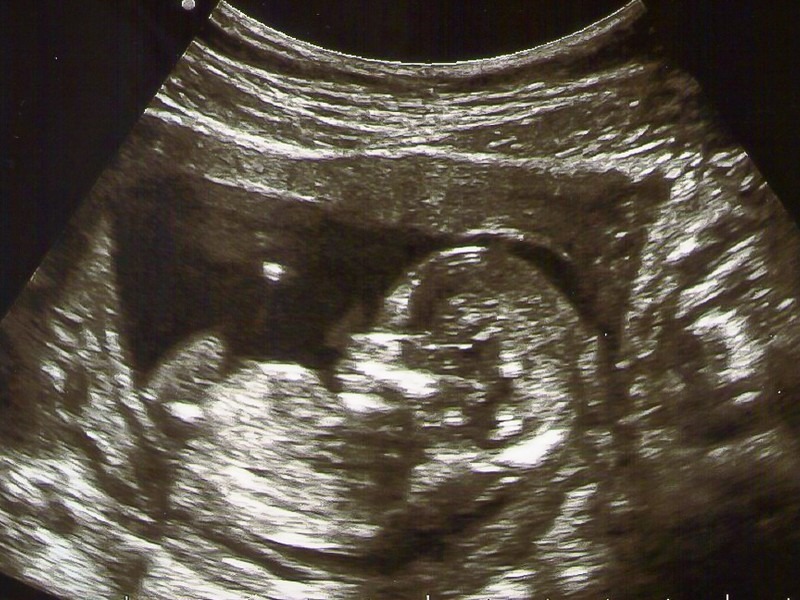
National Happiness Card (국민행복카드 / gugmin haengbok kadeu)
- This card is used to house vouchers from the Ministry of Health and Wellness to assist with certain circumstances. There are several vouchers that can be tacked onto this card, but you must be approved for each one. This card is what you will continue to use from pre-birth and continue after birth for things like daycare.
Vouchers (as of March 2020)
- Health insurance Pregnancy and childbirth medical expenses support*
- Support for pregnant and childbirth medical expenses for adolescent mothers
- Diaper and infant formula support*
- Energy Voucher Support*
- Eight kinds of social service projects
- Babysitting service support
- Female Youth Sanitary Napkin Voucher Support
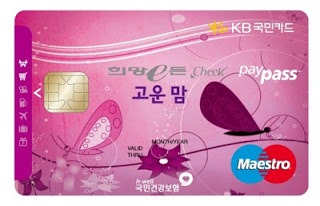
* Indicates which vouchers are offered to foreign/foreign (non-Korean) married couples
- To check to see which vouchers you are eligible for, click here, and (using the Google Translate Chrome extension, if you can’t read Korean), answer the questions.
- If you need further information, call NHIC at 1577-1000 or 02-390-2000 (English Helpline).
- Health Insurance Pregnancy and Childbirth Medical Expenses Support
- Who: Pregnant women or women who have given birth (including miscarriages and stillbirths) with children under the age of one (only eligible if you pay into NHI), including foreign women who are married to foreign men
- What:
- A card used to help pay for medical expenses during and after pregnancy (up until the child(ren) is one year old). Will expire one year after the due date mentioned on the Pregnancy Certificate.
- Can be used at any medical institution where an obstetrician-gynecologist (OB/GYN) works full-time. As of 2013, oriental medical institutions have also been included as designated medical institutions, but double-check with your oriental doctor before going through with any procedures.
- There are three card options: BC Card, Lotte Card, Samsung Card
- Types of cards:
- Credit
- Your credit (Korean) credit will be checked. The company will communicate with your bank.
- You’ll need to provide information about your employment and salary. They will not inform your employer that you are pregnant or which card you are applying for.
- Purchases/Payments are deducted once at the end of the month.
- Check (Debit)
- Must be linked to a bank account that is registered in the same name that is on your ARC.
- You do not have to provide information regarding your employment and salary.
- Purchases/Payments are deducted at checkout.
- Exclusive
- Issued when credit and check cards are not obtainable.
- Credit
- T-Money options are available for credit and debit cards. Just ask when registering to set up that option.
- No annual fee
- Types of cards:
- How Much (as of 2022):
- W1,000,000 for singleton
- W1,400,000 for twins or more
- Money is added if you are considered a high-risk pregnancy as well (doctor’s discretion)
- How to Apply:
- Register online or at any bank that offers the card (listed below)
- Apply:
- Online Registration (Korean website only)
- In-Store Registration: (go to any bank below to register)
- IBK, NH Nonghyup, Daegu Bank, Busan Bank, Kyungnam Bank, Woori Card, Post Office, Suhyup, Jeonbuk Bank, Jeju Bank, Gwangju Bank, SC First Bank
- Bring Pregnancy Certificate, ARC/Passport, and pregnancy booklet (if you received one)
- Phone:
- Samsung Card has an English line (1688-8751)
- Let them know that you are signing up for the “Mom Card” and they will guide you through the process with ease.
- They’ll ask if you want the credit or debit card, then ask you for your information:
- Debit
- ARC number
- Name
- Email address
- Phone number
- Korean credit score
- Credit:
- All above, plus
- Visa Issue Date (Front of your ARC)*
- *Your ARC must not expire within 6 months of applying for the card.
- Debit
- Samsung Card has an English line (1688-8751)
- They will send you either a text message or email while on the phone with them to check your identity.
- They will send you an English application form via email that you will need to fill out and attach a copy of your ARC (front + back) before sending it back to them.
- You’ll get a call from their customer support center double checking all of the information on your application.
- You’ll need to be at your place of work or home when the card is delivered because you need to show your ARC and sign for it.
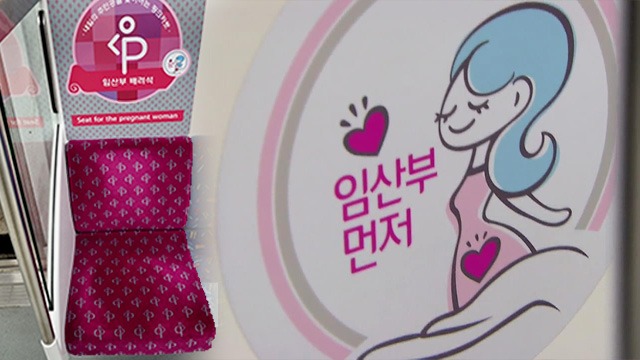
Pregnant Women First Badge (임산부 먼저 / imsanbu meonjeo)
- Who: Pregnant Women
- What: These badges are designed to be attached to either an article of clothing or a purse. Their intended purpose is to assist pregnant women in obtaining priority with respect to seating by making it publicly verifiable that one is, in fact, pregnant.
- Where:
- Local district health center (보건소 / bogeonso)
- Bring your Pregnancy Certificate and ARC/Passport
- Cut and paste 보건소 into Naver Maps to find the one closest to your house. Be sure to append the name of your gu (구) to the front.
- Ex.) Mapo District Health Office (마포구보건소).
- IMPORTANT: If you did not receive a Pregnancy Certificate or you have yet to go to a doctor to confirm you are in fact pregnant, just bring your ARC card to the local district health office and they will first give you a pregnancy test to confirm that you’re pregnant.
- Extra:
- You may also receive some vitamins (folate or folic acid and iron later in pregnancy),
- You will also get messages from them about air pollution or events coming up
- Check the schedule for free yoga and breastfeeding classes.
Local Community Center (주민센터 / jumin senteo)
- Community centers are found in almost all neighborhoods. They are a great resource for families. They offer an array of free and affordable classes. All classes will be offered in Korean unless you luck out tremendously and find a teacher who also speaks English.
- Cut and paste 주민센터 into Naver Maps to find the one that services your neighborhood.
- Do not confuse this with The Multicultural Family Support Center. In Korea, a multicultural family is considered to be a foreigner married to a Korean citizen.
Prenatal Insurance (태아보험 / taeaboheom)
- Major insurance companies offer insurance products for parents to prepare for their babies before giving birth.
- Hyundai Marine and Fire Insurance, Meritz Fire and Marine Insurance, KB Insurance
- The sooner you sign up, the cheaper it is. Sign up in your first trimester.
- It covers the baby till age 8 for something, anything like hospital stays or treatment.
- Heunguk Fire can sometimes accept even in the 2nd trimester and also works like a savings (which allows you to get some money back after the designated time) but you have to sign up for around 30 years… so be sure you want to do that.
- It’s important to look into this prior to finding out if your baby will be born with any abnormalities. In my (Hallie’s) case, at one point, the doctor thought our daughter might be born with congenital heart disease or Autism and she said before we find out, if we were looking to get the prenatal insurance we should do it. If you don’t, then the insurance won’t cover “pre-existing” issues. This is important to be aware of.
Birthing In Korea
If you’ll be giving birth in Korea, you can shop around a bit to find the place that best suits you. Maybe traveling further to a hospital with an English speaking doctor is more comfortable for you. Or, just being closer to your house is more comfortable. In my (Hallie) personal experience, I switched doctors and hospitals three times before I found a birthing clinic I was happy with. They didn’t promote themselves as having English speaking doctors but mine spoke English just fine and had studied in Chicago. I say this so you don’t feel like you have to travel to the big hospitals often touted in English speaking FB groups. There are a lot of options. Just make sure you know what to expect while you’re in labor in Korea. They still use enemas in Korea and traditionally, expect you to be quiet while birthing.
Postnatal care centers/maternity hotels (산후조리원 / sanhu joliwon)
Traditionally, Korean moms spend a week or two in special postnatal care centers to recuperate. These centers replace the traditional care that was provided by the new mother’s mother after her first pregnancy. Here, women learn how to care for their newborn: change diapers, feed/burp, and bathe their baby, etc. Foreign women are welcome to stay at a postnatal care center as well.
To find one, simply search “산후조리원” (sanhu joliwon) in your map app and see where they are located. Most women choose one that is within walking distance of their home. This is for two reasons: their husband can visit and even stay the night but be able to take care of the home and Korean mothers use this as an opportunity to befriend other women who have just had babies as well. After they leave the maternity hotels, they continue to meet up with other new moms. It’s a great way to form baby social groups in your neighborhood.
Don’t wait to find one near you though. Once women find out when they’ll be giving birth, they’ll start going around to look at and book a stay at their local postnatal care center.
Heading home with a baby
Congratulations on becoming a parent! Let the show begin! This section is in the order in which you should acquire all the legal documents to make your baby a legitimate citizen in your home country as well as a foreign resident in South Korea.
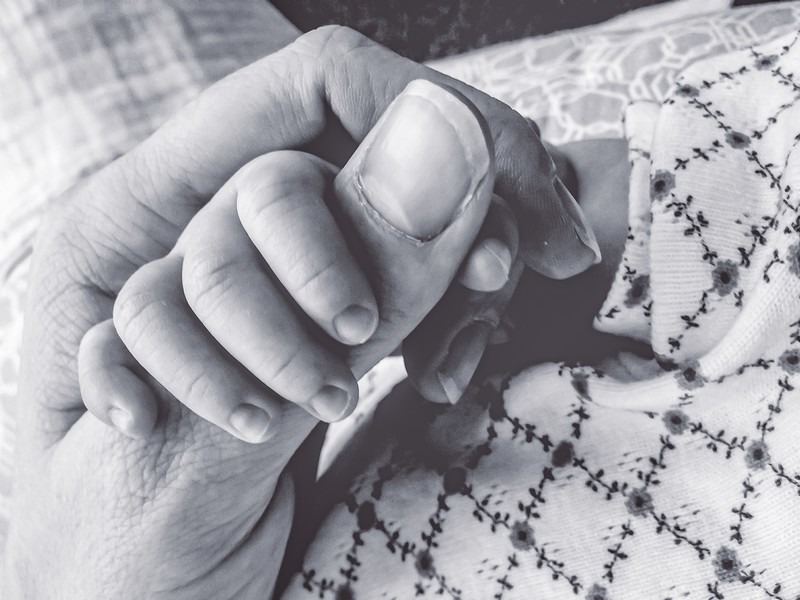
Getting home after the birth
- Things to note;
- Some hospitals may provide a shuttle service for you and your newborn. Inquire a few weeks before your due date to get it all sorted if it’s an option.
- Car seat (카시트 or more commonly used 인명보호 장구를 “life-saving device”):
- There isn’t much in Korean law about the use of car seats.
- Road Traffic Act (도로교통법 /dorogyotongbop)
- Article 50 (Specifications for Specific Drivers) states some information about “life-saving devices,” but not specifically car seats.
- Since regular seat belts are made to only fit adults, the authorities are now requiring children under six years old to be secured in an infant or child car seat. Anyone who will be violating the said law will be imposed with a fine of W60,000 under the improper children and the handicapped protection traffic violation. The law, however, does not specifically indicate the required type of car seat for the mentioned age group.
- Public transit
- If this is your only option to get home after the birth, just take the easiest route home, one with the least amount of transfers.
- Be sure to take all the precautionary measures when carrying your newborn home from the hospital.
- Calling a taxi and paying the extra fees will probably be worth not having to stress about navigating the public transit system right after giving birth.
- You just did the most amazing thing, give yourself this break!
Citizenship: Apply for Baby’s passport and social security card
Parents must immediately apply for a passport for their newborn and bring proof of the application within 30 days of her/his birth to Immigration. Once the passport has been issued, they must return to the Immigration office to file the paperwork necessary to register the baby as a foreign resident. Baby does not have to be present.
Note: Babies born in Korea to foreign nationals are not Korean citizens and must be registered as foreign residents.
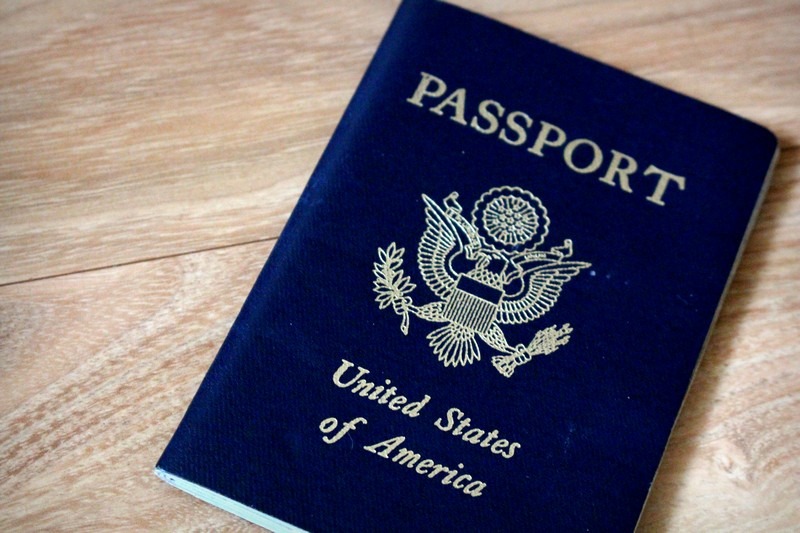
US Citizen Parent(s): (as of Feb 2020)
Remember, this information is under the assumption there are two foreign parents and not one Korean spouse. If you are a multicultural couple in Korea, with one Korean parent and one American parent, there is some information you’ll want to be aware of if your child will have both a Korean and English name.
Here is information about how we got the American passport and then the Korean passport here so that our daughter could have both a legal Korean name and a legal English name.
- US Embassy, Seoul OR US Consulate, Busan
- Apply for a Consular Report of Birth Abroad (CRBA) within 90 days after the birth
- Forms:
- Consular Report of Birth Abroad (CRBA) (Form DS:2029)
- CRBA is an official record confirming that the child acquired U.S. citizenship at birth (outside the US).
- Only the child’s parent(s) or legal guardian(s) can apply for the child.
- Fill out but do not sign. You’ll do that at the US Embassy.
- Passport Application. READ EVERYTHING….TWICE!
- One photo – 2″ x 2” (5cm x 5cm) photograph of your child
- Consular Report of Birth Abroad (CRBA) (Form DS:2029)
- Documents you’ll need:
Originals or certified copies. All originals will be returned.- Child’s birth certificate from hospital (Korean and English)
- Mother’s prenatal and hospital records
- Evidence of U.S. citizenship of the parent(s)
- Parents’ current and previous passports including those issued under other names and other nationalities.
- Evidence of you and your spouse’s relationship prior to the conception of the child.
- Marriage Certificate
- Divorce decrees/Death Certificates, if appropriate
- Fee: $215 ($100 CRBA and $115 Passport) USD or KRW
- Evidence of the American parent’s physical presence in the U.S.
- This one may take you the longest to round up all the documents you need to prove your physical presence in the U.S. Do this in the second or third trimester.
- DNA Examinations, if needed
- If it is not possible to conclusively determine the U.S. citizenship of a child at birth based on the documents submitted, the Consular Officer may request a DNA exam to establish parentage. This will involve the supervised taking of saliva samples from the parties involved by an accredited laboratory.
- Third-party attendance at passport and CRBA appointment interviews, if desired
- Forms:
- Schedule an appointment at the US Embassy in Seoul, but only after you’ve got everything from above! The Embassy is not the place where you want to figure out you forgot something. Double, triple, quadruple check your applications and documents.
- Child’s parent(s) or legal guardian(s) along with the child MUST BE PRESENT to sign the application before a U.S. consular officer.
- Fill out a return delivery courier slip at the Embassy. You will pay for this service in cash directly to the courier upon delivery.
- Apply for a Consular Report of Birth Abroad (CRBA) within 90 days after the birth
- Social Security Card:
- As of October 1, 2017, the US Embassy in Seoul doesn’t accept Social Security Card applications for U.S. citizens under the age of 12.
- Instead, you must go through the Social Security Administration’s Federal Benefits Unit at the U.S. Embassy in Manila (Philippines). (March 27, 2020)Download, complete and sign Application for a Social Security Card (Form SS-5-FS). All questions must be answered legibly.
- Consular Report of Birth Abroad or Birth Certificate of the child
- Send the completed Form SS-5-FS together with the following required documents. All documents submitted must be either originals or certified copies from a U.S. Embassy/Consulate. Uncertified photocopies are not acceptable.
- Valid/Unexpired U.S. Passport of the child
- Valid/Unexpired U.S. Passport or U.S. Government Issued ID (such as U.S. Driver’s License, U.S. Permanent Resident Card, U.S. State Identity Card or U.S. Military ID) of the parent who signed the Form SS-5-FS
- Certified copies can be made at the US Embassy by appointment, free of charge for the purpose of SSN. On your appointment, present the original documents and inform the Consular Staff that you need certified copies which will be used as part of an application for a Social Security Number (SSN)/benefit.
- Mail documents using Fedex, UPS, or DHL with a tracking number.
- They will not return certified copies. They will copy and return original documents within one week by regular mail only. However, you may provide them with a prepaid self-addressed return label for the secure return of the documents. They can only accept return labels/airway bills issued by courier service companies (such as FedEx, UPS or DHL). Their local post office does not accept prepaid registered mail labels issued by foreign postal offices.
- Address:
- Social Security Administration
- U.S. Embassy – Manila
- 1201 Roxas Boulevard, Ermita
- Manila, Philippines 0930
- Address:
Alien Resident Card (ARC) For Newborns with Foreign Parents
For children with two foreign parents in Korea, you need to register the child within 90 days of the child’s birth. The child will be registered under a Family Dependency (F-3) visa. The baby must have their passport to apply.
Forms:
- Foreigners Registration Application (Sojourn Related Forms: Form No. 34)
- Confirmation of Residence/Accommodation (Sojourn Related Forms, left-hand side)
- Fill out Section One for the parent registering the child
- Section Two: Landlord / Provider
- If your employer provides your home:
- Employer will fill out Section 2
- Employer will need to provide you with documents to prove your residence:
- Certified Copy of Register or Residential Lease Agreement
- Copy of your employer’s ID card (front and back)
- If you rent your home:
- Landlord will fill out Section 2
- Landlord will need to provide you will documents to prove your residence:
- Certified Copy of Register or Residential Lease Agreement
- Copy of your Landlord’s ID card (front and back)
- Power of Attorney form – generic form to allow you to sign on your child’s belf. Given to you at Immigration.
- If your employer provides your home:
- Consular Report of Birth Abroad (CRBA) (you received this when applying for the passport)
- Copies of both parent’s ARC (front and back)
- Photo: 3.5cm x 4.5cm
- Fee: 110,000
- Make appointment (Only one parent has to be present. Baby does not have to be present.
- ARC will be mailed to your home in about a month.
Register birth certificate with the local gu (구) office,
Register with National Health Insurance (NHI)
- Either you or your employer can do this.
- You’ll need a Certificate of Foreigner Registration
Make sure to get multiple copies of birth certificates in Korean and English.
- If you want you can start researching daycares and put baby on the waitlists. Or do this when you’re pregnant so you can check out the daycares without the stress of having a baby with you.
- If you have a baby less than one-year-old at home, you can get a 30% discount on your electricity bill of up to 16,000 won per month. Lasts a year.
- What foreigner couples DON’T GET in terms of government support (as of 2020)
- Any assistance with childcare or a monthly stipend as Korean couples do. This has changed in a few placed outside of Seoul so you’ll want to check in your local area to be sure.
- Daycare is usually about 400-500/month or more.
- Monthly stipend from the local government after birth
- Foreign wives bank account
- Assistance/Gifts from the Multicultural Family Support Center (다문화가족지원센터 / damunhwa gajok jiwon sento)
- What foreigner couples DO GET in terms of government support (as of 2020)
- A discount on your electric bill for children 0 to 3 years. You need to register with KEPCO (call 123)
This is a lot of information and if you’ve made it this far and clicked on all of those links above, good for you. Having a baby in Korea, or anywhere for that matter, can be overwhelming. Just take everything one step at a time. You’ll get there… and congratulations.
Did you appreciate this post? Pin IT!
